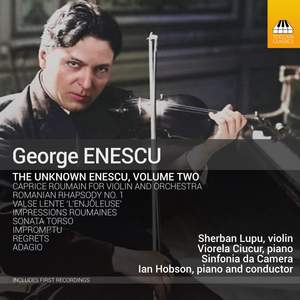
George Enescu (1881-1955)
The Unknown Enescu – Volume Two
Romanian Rhapsody No 1 in A major, Op 11, No 1 (1901; arr. Marcel Stern, publ. 1957)
Impressions Roumaines for solo violin (1925; arr. Lupu, 2008)
Sonata Torso (1911)
Impromptu concertant in G-flat major (1903)
Regrets (1898; compl. Lupu, 2018)
Suite No 1 in G minor, Dans le style ancien, Op 3: Adagio (1897; arr. Sandu Albu, 1929)
Valse lente ‘L’enjoleuse’ (1902)
Caprice Roumain (1925–49; compl. Cornel Ţăranu, 1994–96)
Sherban Lupu (violin)
Viorela Ciucur (piano)
Sinfonia da Camera/Ian Hobson (piano)
rec. 2001-2022
First recordings of the versions of Romanian Rhapsody, Impressions roumaines, Regrets, Adagio, Valse lente
TOCCATA CLASSICS TOCC0647 [72]
Enescu is not as well known as he deserves to be. Yet his compositional aims were similar to those of his near contemporaries in Eastern Europe, Janáček, Bartók and Szymanowski. They all started off as late romantics, learned from Debussy’s impressionism and also incorporated elements of their native folk music into their mature idioms. In fact Holst and Vaughan Williams were doing something comparable in Britain at the same time.
He was a perfectionist who brought relatively few works to the point of publication – there are only 33 opus numbers. Yet he left many works in the form of more or less complete sketches, so that since his death scholars have been preparing them for performance, sometimes completing orchestration or otherwise filling in what the composer did not have time to do himself. There have been two complete symphonies (nos. 4 and 5), the oratorio Strigoii as well as several chamber works.
The violinist Sherban Lupu has long been associated with Enescu’s music. His recording of the second and third violin sonatas, the Suite Impressions d’enfance and his previous recording of the Caprice Roumain,on a two-disc set from Electrecord, is a valuable item in the Enescu discography and there is also another two-disc set by him from Hänssler which I have not heard. Lupu has also been active in ferreting out other violin works. There are numerous sketches and this is the second of two discs featuring works, some of which needed a little tidying up to get into performable shape. (The first disc is reviewed here.)
We begin with the first Romanian Rhapsody, Enescu’s best-known work, though it is early and not typical of his mature style. It is a rousing string of folktunes, opening with an unaccompanied violin passage and featuring dazzling pyrotechnics in the manner of a gypsy fiddler. Here we have, not the orchestral original but a version for violin and piano, in which form the work sounds like a cousin to Ravel’s Tzigane.
Then there is a work for unaccompanied violin, the Impressions roumaines. This is a short suite in four parts in a style which anticipates that of Enescu’s third violin sonata, the one dans le caractère populaire roumain, which is one of his finest works.
The Sonata Torso is all that was written of a projected sonata for violin and piano, namely an imposing but isolated first movement. This would have come between Enescu’s numbered second and third violin sonatas. Here we hear the composer reaching forward from his late romantic idiom to his mature one, but not stably so, which is perhaps why he abandoned the work. It is nonetheless impressive.
We then have four miniatures in a lighter mood. The Impromptu concertant is an attractive but somewhat meandering piece, close to salon music. Regrets really was a salon piece; Enescu wrote this for piano and then began but did not complete a version for violin and piano, which Lupu has here completed. The Adagio was one of the movements of Enescu’s very early first piano suite, dans le style ancien, here transcribed for violin and piano. It offers a late romantic idea of baroque music. The Valso lente L’Enjôleuse was published under a pseudonym as it is completely unlike Enescu’s normally acknowledged works. It is a waltz rather in the Viennese manner and was for a time very popular.
People often wondered why Enescu did not write a concerto for his own instrument. He wrote an early, unfinished and uncharacteristic one (review), but for many years he worked on a Caprice for violin and orchestra which he also never finished. Lupu found the sketches in the Enescu archives in Bucharest and the composer Cornel Tăranu put them together into the four movement Caprice Roumain we have here. Here we have the gypsy fiddling incorporated into a work which is more than an enjoyable romp but a mature masterpiece. It makes a fitting ending to an absorbing programme.
Sherban Lupu has a thorough grasp of the idiom and can toss off the ornaments, slides and ear-tickling passages at the top of the register with the necessary nonchalance. The occasional roughness is part of the idiom. In most of the piano works he is well accompanied by Viorela Ciucur, while Ian Hobson takes the piano part in the Romanian Rhapsody and conducts the Caprice Roumain. These two are live recordings and date from the early 2000s, while the rest were made in the studio in 2022. The recordings are good and the sleevenote, from which I have borrowed, helpful. Enthusiasts will note the number of premiere recordings and need not hesitate; others will also find this rewarding.
Stephen Barber
Previous review: Jonathan Woolf (January 2023)
Help us financially by purchasing from





















